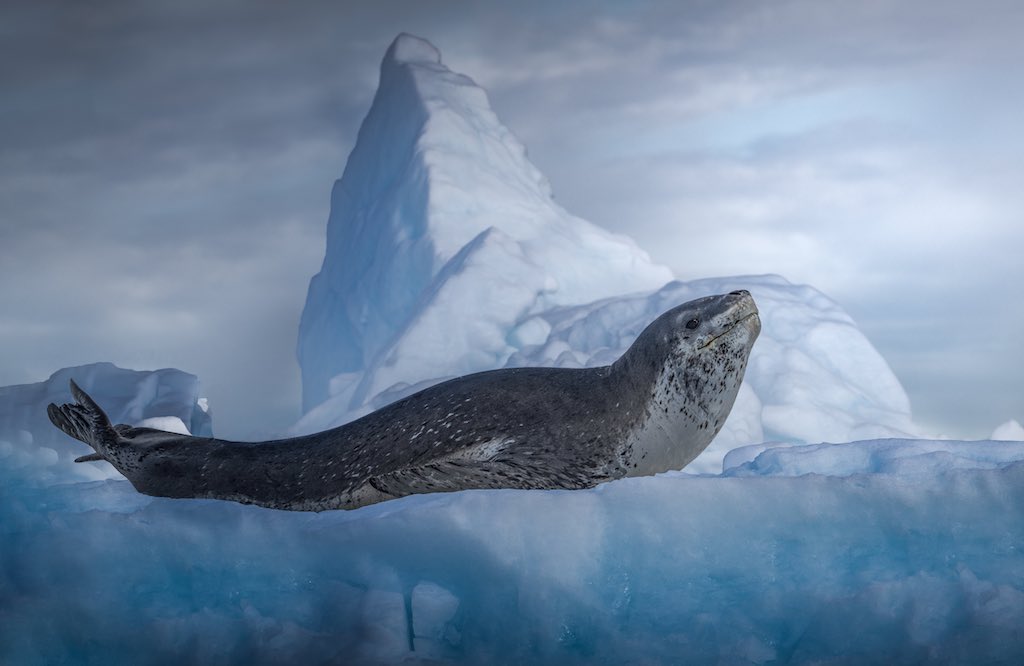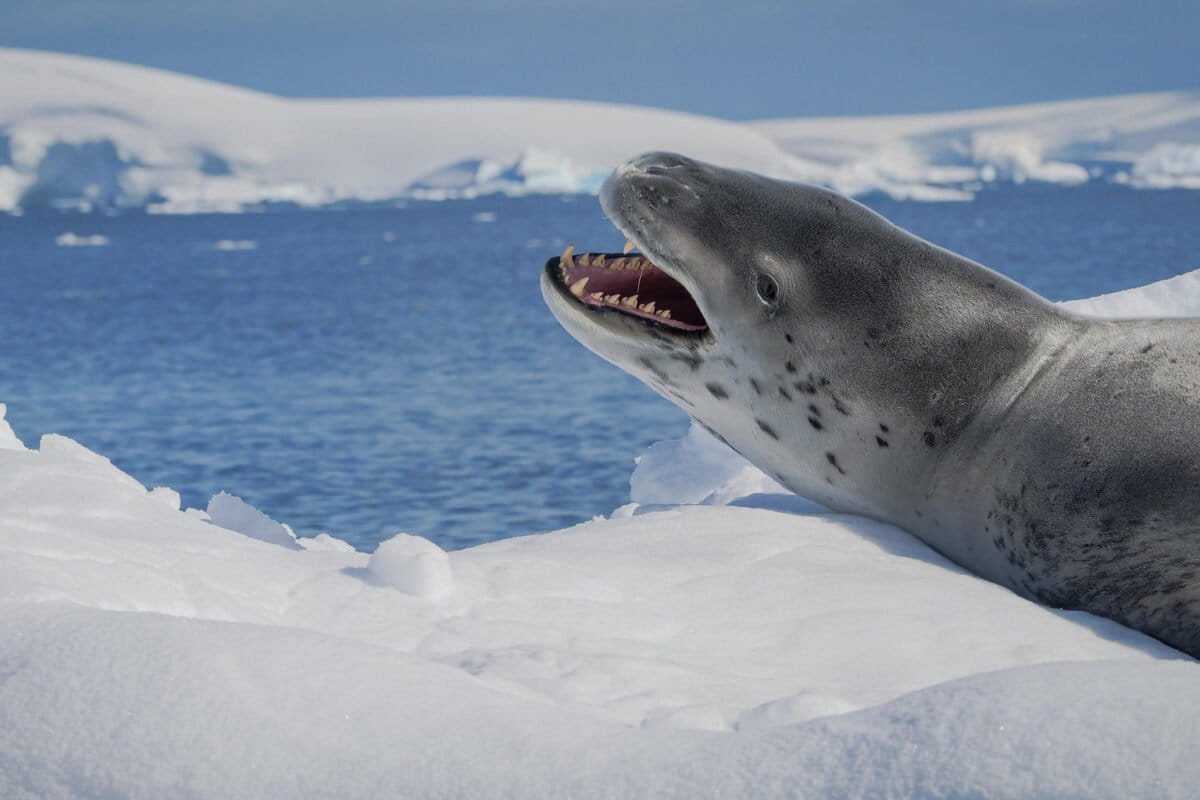- Male leopard seals call out for hours on end during the breeding season, using five sounds to compose unique “songs.”
- Researchers analyzed the underwater vocalizations of male leopard seals in the Davis Sea along Eastern Antarctica’s pack ice.
- The information entropy of the songs, a measure of how predictable or random a sequence is, was remarkably close to that of human nursery rhymes.
- While many mammals can vocalize, few create complex songs, and leopard seals join a select group that includes humpback whales, sperm whales, gibbons, and even mice in assembling sounds into structured sequences.
In the cathedral of ice beneath Antarctica’s frozen sea, male leopard seals conduct their solitary concerts. Day after day, sometimes for 13 hours straight, these predators plunge into the frigid waters, calling out in moans and chirps as loud as a jet plane. They emerge only to refill their lungs before diving back down to transmit their message across the vast Antarctic seascape.
“They’re like the songbirds of the Southern Ocean,” said Tracey Rogers, a professor at the University of New South Wales (UNSW) in Australia, who has collected leopard seal sound recordings since the 1990s. “During the breeding season, if you drop a hydrophone into the water anywhere in the region, you’ll hear them singing.”
She added, “They’re incredibly committed.”
A new study, published in Nature, analyzed the underwater vocalizations of 26 male leopard seals (Hydrurga leptonyx) in the Davis Sea along Eastern Antarctica’s pack ice.
Scientists used a mathematical model called “information entropy” to measure the predictability of these notes and sounds and how they compare to other mammal calls, including human music ranging from the Beatles to Bach. They found that leopard seal mating calls are similar in predictability to human nursery rhymes.

“When we compared their songs to other studies of vocal animals and of human music, we found their information entropy — a measure of how predictable or random a sequence is — was remarkably close to our own nursery rhymes,” says Lucinda Chambers, a doctoral candidate ate UNSW and lead author of the study. “Leopard seal songs have a surprisingly structured temporal pattern.”
The songs are less random than the Beatles, Mozart or baroque music, but only slightly more random or complex than simple children’s songs such as “Twinkle, Twinkle, Little Star,” or the other 39 tunes the researchers selected from The Golden Song Book by Katherine Tyler Wessells. These nursery rhymes follow very predictable patterns, while leopard seal songs have more variety in their sequences.
These large mammals (up to 3.4 meters or 11 feet long, and weighing up to 590 kilograms or 1,300 pounds) are a keystone species and apex predators. They eat penguins, smaller seals, fish, squid and krill, and in turn are preyed on by killer whales.
In the Antarctic spring and summer, males tend to be alone and far-flung, so they call for many hours using recognizable patterns, likely to increase their chances of being heard. These songs are thought to attract mates and signal the bounds of their territories, a “come hither” to the females and “go away” to the males.
Leopard seal males produce loud calls of 153 to 177 decibels, roughly equivalent to standing next to a jet engine during takeoff or experiencing a gunshot at close range. They use five distinct calls that researchers call double trills, medium single trills, low descending trills, low double trills, and a hoot with a low single trill.
While the sounds are rather consistent, their order changes among individual seals. Each seal uses these five sounds to compose its own unique song, sticking with particular patterns for days at a time like a musical signature.
“You can’t tell them apart by how the call sounds,” Rogers says. “It’s the order and pattern that matters. They’ve stylised it to an almost boring degree, which we think is a deliberate strategy, so their call carries a long distance across the ice.”
Scientists still don’t fully understand what these songs mean, but Chambers says “it’s like they’re saying, ‘I’m the biggest and the strongest, look how long and how loud I can sing.’”
While many mammals can vocalize, few create complex songs like birds do. Leopard seals join a select group that includes rock hyraxes (Procavia capensis), free-tailed bats (Tadarida brasiliensis), gibbons (genus Hylobates), mice (Mus musculus) humpback whales (Megaptera novaeangliae),orangutans (genus Pongo), squirrel monkeys (Saimiri sciureus), sperm whales (Physeter macrocephalus), killer whales (Orcinus orca), short-finned pilot whales (Globicephala macrorhynchus) and bottlenose dolphins (Tursiops truncatus).
Compared to other singing animals, leopard seals pack more information into their songs. Researchers say this likely helps their calls travel clearly across vast distances without getting garbled — crucial for animals spread across the enormous Antarctic seascape.
This new research “demonstrates the difficulties scientists face in trying to identify the rules that govern animal vocal sequences and to decipher the messages encoded within them,” said Rüdiger Riesch, a senior lecturer in evolutionary biology at Royal Holloway, University of London, who wasn’t involved in the study.
“We want to know if new call types have emerged in the population,” Chambers said. “And if patterns evolve from generation to generation. We’d love to investigate whether their ‘alphabet’ of five sounds has changed over time.”
Banner image of a leopard seal by Charles (Chuck) Peterson via Flickr (CC BY-NC-ND 2.0).
Liz Kimbrough is a staff writer for Mongabay and holds a Ph.D. in Ecology and Evolutionary Biology from Tulane University, where she studied the microbiomes of trees. View more of her reporting here.
Study unveils mystery of monkey yodeling — and why humans can’t compete
Citation: Chambers, L. E., Buck, J. R., & Rogers, T. L. (2025). Leopard seal song patterns have similar predictability to nursery rhymes. Scientific Reports, 15(1), 26099. doi:10.1038/s41598-025-11008-8
FEEDBACK: Use this form to send a message directly to the author of this post. If you want to post a public comment, you can do that at the bottom of the page.
Source link
#Leopard #seals #sing #songs #similar #nursery #rhymes #study
